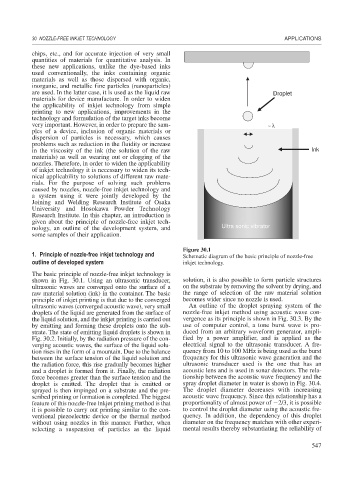Page 575 - Book Hosokawa Nanoparticle Technology Handbook
P. 575
30 NOZZLE-FREE INKJET TECHNOLOGY APPLICATIONS
chips, etc., and for accurate injection of very small
quantities of materials for quantitative analysis. In
these new applications, unlike the dye-based inks
used conventionally, the inks containing organic
materials as well as those dispersed with organic,
inorganic, and metallic fine particles (nanoparticles)
are used. In the latter case, it is used as the liquid raw Droplet
materials for device manufacture. In order to widen
the applicability of inkjet technology from simple
printing to new applications, improvements in the
technology and formulation of the target inks become
very important. However, in order to prepare the sam- ∼ λ
ples of a device, inclusion of organic materials or
dispersion of particles is necessary, which causes
problems such as reduction in the fluidity or increase
in the viscosity of the ink (the solution of the raw Ink
materials) as well as wearing out or clogging of the
nozzles. Therefore, in order to widen the applicability
of inkjet technology it is necessary to widen its tech-
nical applicability to solutions of different raw mate-
rials. For the purpose of solving such problems
caused by nozzles, nozzle-free inkjet technology and
a system using it were jointly developed by the
Joining and Welding Research Institute of Osaka
University and Hosokawa Powder Technology
Research Institute. In this chapter, an introduction is
given about the principle of nozzle-free inkjet tech-
nology, an outline of the development system, and Ultra sonic vibrator
some samples of their application.
Figure 30.1
1. Principle of nozzle-free inkjet technology and Schematic diagram of the basic principle of nozzle-free
outline of developed system inkjet technology.
The basic principle of nozzle-free inkjet technology is
shown in Fig. 30.1. Using an ultrasonic transducer, solution, it is also possible to form particle structures
ultrasonic waves are converged onto the surface of a on the substrate by removing the solvent by drying, and
raw material solution (ink) in the container. The basic the range of selection of the raw material solution
principle of inkjet printing is that due to the converged becomes wider since no nozzle is used.
ultrasonic waves (converged acoustic wave), very small An outline of the droplet spraying system of the
droplets of the liquid are generated from the surface of nozzle-free inkjet method using acoustic wave con-
the liquid solution, and the inkjet printing is carried out vergence as its principle is shown in Fig. 30.3. By the
by emitting and forming these droplets onto the sub- use of computer control, a tone burst wave is pro-
strate. The state of emitting liquid droplets is shown in duced from an arbitrary waveform generator, ampli-
Fig. 30.2. Initially, by the radiation pressure of the con- fied by a power amplifier, and is applied as the
verging acoustic waves, the surface of the liquid solu- electrical signal to the ultrasonic transducer. A fre-
tion rises in the form of a mountain. Due to the balance quency from 10 to 100 MHz is being used as the burst
between the surface tension of the liquid solution and frequency for this ultrasonic wave generation and the
the radiation force, this rise gradually becomes higher ultrasonic transducer used is the one that has an
and a droplet is formed from it. Finally, the radiation acoustic lens and is used in sonar detectors. The rela-
force becomes greater than the surface tension and the tionship between the acoustic wave frequency and the
droplet is emitted. The droplet that is emitted or spray droplet diameter in water is shown in Fig. 30.4.
sprayed is then impinged on a substrate and the pre- The droplet diameter decreases with increasing
scribed printing or formation is completed. The biggest acoustic wave frequency. Since this relationship has a
feature of this nozzle-free inkjet printing method is that proportionality of almost power of 2/3, it is possible
it is possible to carry out printing similar to the con- to control the droplet diameter using the acoustic fre-
ventional piezoelectric device or the thermal method quency. In addition, the dependency of this droplet
without using nozzles in this manner. Further, when diameter on the frequency matches with other experi-
selecting a suspension of particles as the liquid mental results thereby substantiating the reliability of
547

